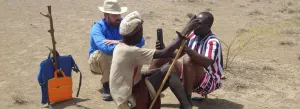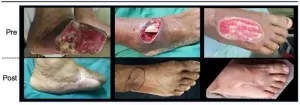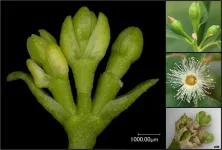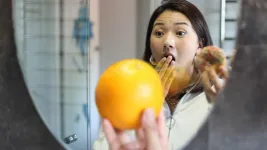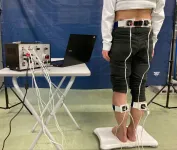Wild barley from Jordan holds key to stem rust resistance
2021-04-07
(Press-News.org) Stem rust is a devastating disease of cereal crops, including barley, one of the first domesticated crops in agriculture and the fourth most widely grown crop in the world. Barley is unique because it is one of only a few crops that can be cultivated in almost any climate and across a range of elevations, making it economically and nutritionally important.
Stem rust is one of the biggest threats to barley production and capable of causing complete crop loss during severe epidemics. And since barley is also used as malt for beer and spirits and feed for animals in addition to food for humans, many industries have a vested interest in making sure barley is protected from stem rust outbreaks.
One of the most important variants of the stem rust pathogen is Ug99, which first emerged in Uganda in the late 1990s and has since spread across Africa and into the Middle East. Races in the Ug99 lineage pose a great threat to cereal production worldwide and with respect to barley are virulent on more than 95% of the cultivars worldwide. Few studies have been done to identify resistance in barley to Ug99 races, but a recent study from the University of Minnesota has made advances in this area.
Led by Eva Henningsen, who was an undergraduate student at the time of this research, plant pathologists at the university turned to a diverse collection of wild barley and discovered several accessions from Jordan that exhibited a high level of stem rust resistance. They then hybridized these wild accessions and, in a significant discovery, found that a single dominant gene, which they designated Rpg7, was responsible for this resistance.
"This gene will be a valuable addition to breeding programs," explained Brian Steffenson, one of the plant pathologists involved with this research. "Given that the resistant wild barley accessions were discovered in Jordan, this research will also provide clues as to where one might possibly identify additional sources of stem rust resistance."
INFORMATION:
For more information about this discovery and the process behind it, read " END
[Attachments] See images for this press release:
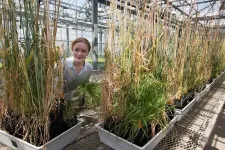
ELSE PRESS RELEASES FROM THIS DATE:
2021-04-07
Thirty years ago, clinical psychiatrist Jonathan Shay drew attention to similarities between the trauma experienced by the Greek warriors, as documented in the epic poem "The Iliad," and Vietnam veterans in America. Could the experience of war impact people in similar ways in vastly different cultural milieus?
Research published this week by ASU researcher Sarah Mathew and former ASU postdoctoral researcher Matthew Zefferman in the Proceedings of the National Academy of Sciences shows that Turkana pastoralist warriors from Kenya also experience PTSD (post-traumatic stress disorder) symptoms, even though their lifestyles and combat experiences are ...
2021-04-07
Direct human alterations to natural aquatic ecosystems can increase methane emissions, a new study has found.
Atmospheric methane has tripled since pre-industrial times. It traps heat far more effectively than carbon dioxide and accounts for 25% of atmospheric warming to date. And much of that methane is coming from aquatic ecosystems, with human activities contributing to the emissions levels, a new paper published in Nature Geoscience has found.
The global contribution and importance of aquatic ecosystems as methane emitters has been underestimated, ...
2021-04-07
Anyone who has visited the Australian outback would be familiar with spinifex grasses, which cover almost a fifth of our continent.
Like many scientists, they may have also wondered why this iconic arid grass grows in striking ring shapes.
Previous studies have tested whether spinifex rings could be caused by termites, water availability or nutrient depletion, but none has provided a convincing explanation.
Now scientists from UNSW Sydney have found that pathogenic soil microbes play a role in how the spinifex got its hole.
Their study, the first of its kind in an arid ecosystem, has been published in the Australian Journal of Botany.
Professor Angela Moles and Neil Ross from ...
2021-04-07
Durham, NC - According to the results of a phase 1 clinical trial just published in STEM CELLS Translational Medicine, a new stem cell therapy shows promise of making diabetes-related amputations a thing of the past. The trial involved injecting diabetes patients suffering from non-healing diabetic foot ulcers (DFU) with a cell preparation containing adult stem cells harvested from their own fat. The results showed that the treatment induced regeneration of the blood vessels surrounding the DFUs, accelerated healing - all with no serious side effects.
"Non-healing diabetic foot ulcers usually ...
2021-04-07
CORVALLIS, Ore. - Eucalyptus, a pest-resistant evergreen valued for its hardy lumber and wellness-promoting oil, can be genetically modified not to reproduce sexually, a key step toward preventing the global tree plantation staple from invading native ecosystems.
Oregon State University's Steve Strauss led an international collaboration that showed the CRISPR Cas9 gene editing technique could be used with nearly 100% efficiency to knock out LEAFY, the master gene behind flower formation.
"The flowers never developed to the point where ovules, pollen or ...
2021-04-07
Two thirds of New Zealanders believed there were 'silver linings' to the country's Alert Level 4 COVID-19 lockdown imposed in March last year, a University of Otago survey has found.
The researchers were able to question New Zealanders while they were at home, giving a unique insight into their lives during the nationwide lockdown between 25 March and 23 April, widely regarded as one of the strictest imposed anywhere in the world.
One year on from lockdown, the results of their study have been published in the international scientific journal, PLOS ONE.
Participants were asked 'Have you experienced any silver linings, or positive aspects during the COVID-19 Level 4 lockdown' and were able to answer 'yes, for me personally', ...
2021-04-07
Can a mirror turn an orange into a doughnut? The answer is definitely no in the real (macro) world. But at the nanoscale, a mirror can turn an "orange" shaped pattern into a "doughnut" shaped pattern by overlapping the "orange" with its reflected mirror image.
A team of researchers from the University of Technology Sydney (UTS) has shown for the first time that fluorescent nanoparticles placed near a mirror generate unique patterns that can be used to pinpoint their location.
The researchers attribute this effect to the light emitting nanoparticle's interference with its own mirror image. Using this method they can also detect the size of particles to a resolution of one nanometre - or around 1/80,000th of the diameter of a human ...
2021-04-07
Areas with a relatively greater amount of misogynistic tweets have higher incidences of domestic and family violence, a UNSW study has found.
The study, published in Psychological Science, not only found this connection with domestic and family violence carried over from one year to the next, but also occurred despite the 'usual suspects' of domestic violence, such as alcohol and inequality.
Examples of misogynistic tweets identified by the researchers included, "Women are all bitches," "Whore had it coming," and, "Make me a sandwich, slut."
"We found that misogynistic ...
2021-04-07
Ever since the early humans learned to walk upright, they have suffered, as an unfortunate consequence of their erect posture, from low back pain. Modern understanding on this matter dictates that low back pain, in particular, is caused due to a postural instability resulting from poor "proprioception", which is a term for the perception of part of our body's own position in space. In fact, our trunk and lower legs are key to maintaining postural stability due to the presence of "proprioceptors"--sensory receptors responding to position and movement--in those areas.
Elderly people suffering from low back pain tend to have poorly performing proprioceptors, ...
2021-04-07
COLUMBUS, Ohio - Researchers have found a way to use chaos to help develop digital fingerprints for electronic devices that may be unique enough to foil even the most sophisticated hackers.
Just how unique are these fingerprints? The researchers believe it would take longer than the lifetime of the universe to test for every possible combination available.
"In our system, chaos is very, very good," said Daniel Gauthier, senior author of the study and professor of physics at The Ohio State University.
The study was recently published online in the journal IEEE Access.
The researchers created a new version ...
LAST 30 PRESS RELEASES:
[Press-News.org] Wild barley from Jordan holds key to stem rust resistance

